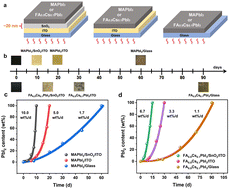Thermal instability originating from the interface between organic–inorganic hybrid perovskites and oxide electron transport layers†
Abstract
The thermal instability of organic–inorganic halide perovskite solar cells (PSCs) is one of the most important factors restraining their commercialization. It has recently been reported that modifications at the interface between the electron transport layer (ETL) and the perovskite layer could effectively promote the long-term thermal stability of high-efficiency PSCs. However, few studies have disclosed the effect of the microstructure of ETLs, such as SnO2 or TiO2, on the thermal degradation pathway of the perovskite layer at nano-, or even atomic-scale, resolution. In this work, a variety of characterization techniques were used to detect the diffusion of the oxygen element from SnO2/TiO2 layers into organic–inorganic hybrid perovskite (OIHP) layers, which was accompanied by the thermal decomposition of MAPbI3 and FA0.9Cs0.1PbI3 films. Moreover, a preferential thermal decomposition of the perovskite layer at the SnO2–perovskite interface was confirmed to be an adverse factor inducing the performance degradation of PSCs. First-principles calculations further elucidate that dangling bonds at the SnO2 or TiO2 ETL–perovskite interface down-regulate the oxygen vacancy formation energy. Furthermore, a low segregation energy for oxygen diffusion (0.19–0.55 eV and 0.26 eV at SnO2 and TiO2–perovskite interfaces, respectively) accelerates the transfer of the oxygen element from SnO2 or TiO2 into OIHP layers and promotes the transfer of protons in the perovskite layer. Furthermore, the fabrication of planar OIHP solar cells based on an O2-plasma treated ETL SnO2 layer effectively improved their photoelectric performance and thermal stability, further confirming the important role of interfacial oxygen in modulating the stability of PSC devices.



 Please wait while we load your content...
Please wait while we load your content...